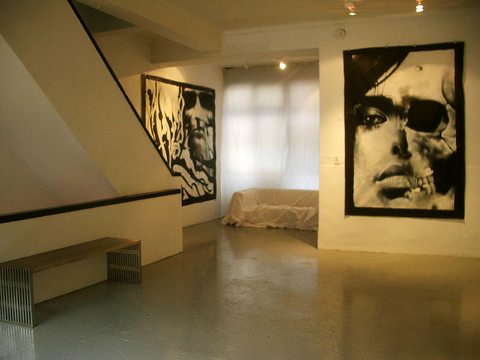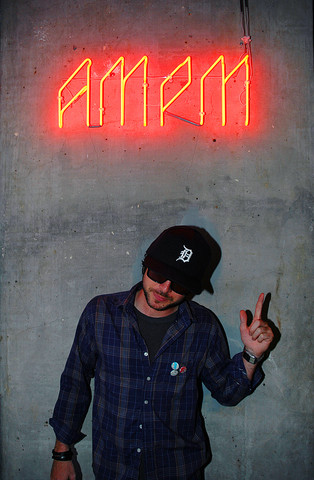BAPE, Proton, K-Swiss and Motorola are companies that manufacture completely different products — clothes, TVs, shoes and mobile phones — but all have worked with street artists to promote their wares.
In a world obsessed with cool and the next big thing, forward-thinking companies are desperate to impress trend-setting buyers. One of the easiest, and most successful, ways to do that is to associate their products with high-profile artists, and the cooler the better.
In Taipei, local street artists Reach and Ano tagged Proton TVs. UK legend She1 did a live painting for Royal Elastics in May. And K-Swiss flew out Fremantle and Grand High from France and the US respectively for K Spray 2 in April. Breaking away from this commercial trend, AMPM Gallery is taking back the street by hanging graffiti on its walls.

PHOTO COURTESY OF DBSK1
The appropriation of street art by company marketing machines sits awkwardly with an art form that is viewed as vandalism by authorities and the practitioners of which often break the law.
Despite its proliferation on the Internet, and use in slick PR campaigns, graffiti and stenciling retain a rebellious streak. Sharing that belief in rebelliousness, even if sometimes misplaced, like-minded artists have created grassroots communities.
DBSK1, a foreign graffiti artist living in Taipei, opened AMPM Gallery in March last year as a venue to showcase street art, free from the glare of authorities.

PHOTO COURTESY OF SARAH MCMASTER
DBSK1 and his old crew, Asia Nites, were frustrated with the availability and quality of places to display street art. They aimed to display less commercial forms of street art than big companies were using to market their products. "I'm not against [these corporate shows]," said DBSK1. "An artist, to a certain extent, has to support themselves and I understand doing crossover stuff. But it makes the scene more commercialized," and thus, "softer." What's lost, then, is the street edge or style. Through exhibiting work by local and foreign artists, AMPM aims to reconnect street art to unconformity, even if it is displayed in a gallery.
All of AMPM’s four shows so far have featured local talent. Love Hotel, the gallery’s first show, exhibited the work of 22 artists. The second, featured Beans & Bueller's twisted, yet cute, puppets roaming a post-apocalyptic city. AMPM’s last show displayed photography by Kent Dylan and finished yesterday.
So far, the shows have attracted a peculiar mix of foreigner party people, local graffiti kids, hipsters, and middle-aged spectators. "It's really cool; I really like [the mix we've got]," says DBSK1. "But it's not consistent. We want to hype" the venue and take it to the next level, to educate the general public about the art that's happening in their city.
AMPM’s Notebook exhibition starts Saturday and examines the artistic process. Over 20 artists' notebooks will be posted throughout the gallery, allowing viewers a rare glimpse into each individual's personal world and their creative process. Attendees are encouraged to take along their own sketches. The show of rough drafts, sketches, and random, spontaneous work provides a unique insight into members of Taipei’s art scene.

In the March 9 edition of the Taipei Times a piece by Ninon Godefroy ran with the headine “The quiet, gentle rhythm of Taiwan.” It started with the line “Taiwan is a small, humble place. There is no Eiffel Tower, no pyramids — no singular attraction that draws the world’s attention.” I laughed out loud at that. This was out of no disrespect for the author or the piece, which made some interesting analogies and good points about how both Din Tai Fung’s and Taiwan Semiconductor Manufacturing Co’s (TSMC, 台積電) meticulous attention to detail and quality are not quite up to

April 21 to April 27 Hsieh Er’s (謝娥) political fortunes were rising fast after she got out of jail and joined the Chinese Nationalist Party (KMT) in December 1945. Not only did she hold key positions in various committees, she was elected the only woman on the Taipei City Council and headed to Nanjing in 1946 as the sole Taiwanese female representative to the National Constituent Assembly. With the support of first lady Soong May-ling (宋美齡), she started the Taipei Women’s Association and Taiwan Provincial Women’s Association, where she

It is one of the more remarkable facts of Taiwan history that it was never occupied or claimed by any of the numerous kingdoms of southern China — Han or otherwise — that lay just across the water from it. None of their brilliant ministers ever discovered that Taiwan was a “core interest” of the state whose annexation was “inevitable.” As Paul Kua notes in an excellent monograph laying out how the Portuguese gave Taiwan the name “Formosa,” the first Europeans to express an interest in occupying Taiwan were the Spanish. Tonio Andrade in his seminal work, How Taiwan Became Chinese,

Mongolian influencer Anudari Daarya looks effortlessly glamorous and carefree in her social media posts — but the classically trained pianist’s road to acceptance as a transgender artist has been anything but easy. She is one of a growing number of Mongolian LGBTQ youth challenging stereotypes and fighting for acceptance through media representation in the socially conservative country. LGBTQ Mongolians often hide their identities from their employers and colleagues for fear of discrimination, with a survey by the non-profit LGBT Centre Mongolia showing that only 20 percent of people felt comfortable coming out at work. Daarya, 25, said she has faced discrimination since she